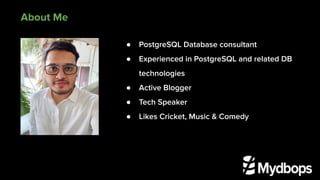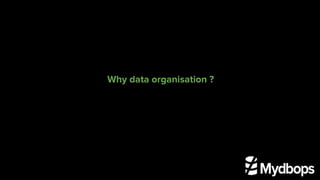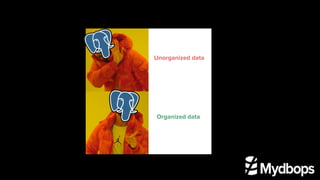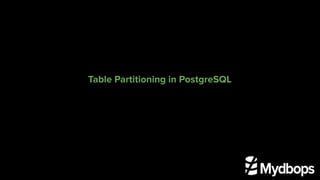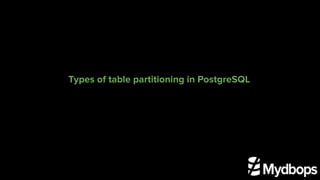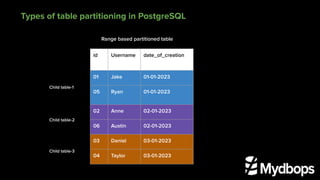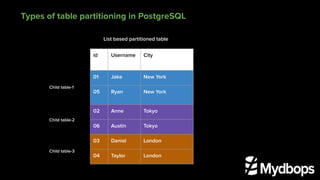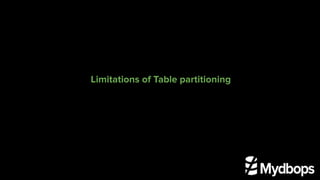Data Organisation: Table Partitioning in PostgreSQL
- 1. Mastering data organisation: Deep dive into PostgreSQL table partitioning Presented by Mohammad Zaid Patel Mydbops Mydbops MyWebinar - 30 Dec 23rd, 2023
- 2. About Me ● PostgreSQL Database consultant ● Experienced in PostgreSQL and related DB technologies ● Active Blogger ● Tech Speaker ● Likes Cricket, Music & Comedy
- 3. Consulting Services Consulting Services Managed Services ● Database Management and consultancy provider ● Founded in 2016 ● Assisted 800+ happy customers ● AWS partners ● PCI & ISO certified About Us
- 4. ● Why data organisation ? ● Advantages of data organisation ● Techniques of data organisation ● Table partitioning in PostgreSQL ● Table partition techniques ● Demo for table partitioning using pg_partman ● Limitations of table partitioning ● Best practices for table partitioning Agenda
- 6. ● Databases are used for storing and retrieving data ● Database becomes a black box ● Piled up with un-organised data ● Performance degradation of the database Why data organization?
- 7. ● Organization of data is very essential for the database functionality ● Plays crucial roles in database efficiency ● Assures data integrity ● Improves the usability of the stored data Why data organization?
- 9. Advantages of organizing your data
- 10. Advantages of organizing your data ● Better data retrieval ● Improved query performance ● Data integrity ● Efficient storage and resource utilization ● Ease in maintenance ● Ease in scalability of the database ● Data analysis and reporting
- 12. Data organization techniques Index creation : - Creates a data structure that allows quick access to rows based on specific column values - Faster data retrieval for conditions involving indexed columns - Types: B-tree, GIN,Hash indexes etc Data Archival: - Process of moving the old data to a different location - Clean up database - Helps in managing the data efficiently over time
- 13. Data organization techniques Schemas: - Collection of database objects organized into a named namespace - Provides a way to logically group and organize database objects within a database - Multiple schemas with each schema having its own set of objects. Functional naming of database objects: - Helps in noting the type of database objects e.g. indexes, views , sequences etc - Easier for the users to understand the database structure and work with the objects more effectively
- 14. Data organization techniques Relationships among database objects: - Avoids creation of "orphaned" records and maintaining consistency across related tables. - Efficient queries that involve data from multiple tables like JOIN operations Table partitioning: - Involves dividing large tables into smaller, more manageable pieces - Improves query performance, data management, and maintenance tasks - Data distribution across partitions.
- 15. Table Partitioning in PostgreSQL
- 16. Table Partitioning in PostgreSQL ● Database design technique that involves dividing large tables into smaller, more manageable segments called partitions id Name Cricket club 01 Virat RCB 02 Dhoni CSK 03 Rohit MI 04 Hardik MI 05 Siraj RCB 06 Jadeja CSK id Name Cricket club 01 Virat RCB 05 Siraj RCB 02 Dhoni CSK 06 Jadeja CSK 03 Rohit MI 04 Hardik MI Child table-1 Child table-2 Child table-3 Normal Table Partitioned Table Parent table
- 17. ● Partition key, determines how data is distributed across partitions ● Efficient data management, especially for operations like data insertion, updates, and deletions. ● Enhances query performance by allowing the database to selectively scan only relevant partitions when queries involve conditions on the partition key ● Ease in data archival Table Partitioning in PostgreSQL
- 18. Types of table partitioning in PostgreSQL
- 19. Types of table partitioning in PostgreSQL PostgreSQL supports different partitioning methods including range partitioning , list partitioning, and hash partitioning. Range Partitioning: - Divides a table into partitions based on ranges of values in a chosen partition key column - Partitioning by a date column, each partition may represent a specific time period, such as months or years Creating a child table : CREATE TABLE child_table_2022_01_01 PARTITION OF parent_table FOR VALUES FROM ('2022-01-01') TO ('2023-02-01');
- 20. Types of table partitioning in PostgreSQL id Username date_of_creation 01 Jake 01-01-2023 05 Ryan 01-01-2023 02 Anne 02-01-2023 06 Austin 02-01-2023 03 Daniel 03-01-2023 04 Taylor 03-01-2023 Child table-1 Child table-2 Child table-3 Range based partitioned table
- 21. Types of table partitioning in PostgreSQL List based Partitioning: - Divides a table into partitions based on specific values in a chosen partition key column. - Rows with values falling within specific ranges of this key are grouped into individual partitions Creating a child table : CREATE TABLE new_york_child_table PARTITION OF parent_table FOR VALUES IN (‘New York’);
- 22. Types of table partitioning in PostgreSQL id Username City 01 Jake New York 05 Ryan New York 02 Anne Tokyo 06 Austin Tokyo 03 Daniel London 04 Taylor London Child table-1 Child table-2 Child table-3 List based partitioned table
- 23. Types of table partitioning in PostgreSQL Hash based Partitioning: - Divides a table into partitions based on the hash value of a chosen partition key column - Uniform distribution of data across partitions by using a hash function Creating a child table : CREATE TABLE child_table_1 PARTITION OF parent_table FOR VALUES WITH (MODULUS 3,REMAINDER 0);
- 24. Types of table partitioning in PostgreSQL id Username City 01 Anne New York 05 Taylor Tokyo 02 Jake Tokyo 06 Austin London 03 Daniel London 04 Ryan New York Child table-1 Child table-2 Child table-3 List based partitioned table Remainder value 0001 0001 0002 0002 0003 0003
- 25. Partitioning techniques in PostgreSQL
- 26. Partitioning techniques in PostgreSQL 1. Manual Partitioning: - Creating parent tables and child tables manually - Maintenance of the child tables should be taken care of E.g Creating a parent table : CREATE TABLE parent_table ( id int,date_column DATE, value INTEGER, CONSTRAINT pkey PRIMARY KEY (id,date_column) ) PARTITION BY RANGE (date_column);
- 27. Partitioning techniques in PostgreSQL E.g Creating a child table : CREATE TABLE child_table_2022 PARTITION OF parent_table FOR VALUES FROM ('2022-01-01') TO ('2023-01-01');
- 28. Partitioning techniques in PostgreSQL 2. Partitioning using pg_partman extension: - Extension designed to create and oversee sets of partitioned tables - The creation of child tables is fully managed by the extension itself - The extension includes a background worker (BGW) process to streamline partition maintenance - Optional retention policy that can automatically discard partitions that are no longer necessary - Maintenance function takes cares of partition management on timely basis
- 29. Partitioning techniques in PostgreSQL pg_partman extension is required: demo_db=# dx List of installed extensions Name | Version | Schema | Description ------------+---------+------------+--------------------------------- --------------------- pg_partman | 4.7.3 | partman | Extension to manage partitioned tables by time or ID
- 30. Partitioning techniques in PostgreSQL Creating a parent table : Creating a child table : CREATE TABLE parent_table ( id integer ,created_date date, CONSTRAINT table01_pkey PRIMARY KEY (id,created_date) ) partition by range(created_date); SELECT partman.create_parent( p_parent_table => 'public.parent_table’, p_control => 'created_date', p_interval=> '1 day', p_premake => 2);
- 31. Demo
- 32. Limitations of Table partitioning
- 33. Limitations of Table partitioning ● Useful only when the partition key is used ● Regular supervision is required for the pg_partman tool for partition management ● Complexities in data migration services ● Complexities in tables with foreign key relationships ● Child tables that are stored as backup needs to be taken care ● Data accumulation in default table fails the pg_partman functions
- 34. Best practices for partitioned table maintenance
- 35. ● Choose the Right Partition Key ● Understand Query Patterns ● Monitor and Tune Performance ● Choose Appropriate Partitioning Method ● Limit the Number of Partitions ● Implement Data Archiving ● Regularly Update PostgreSQL Version Best practices for partitioned table maintenance
- 36. Any Questions ?
- 37. Consulting Services Consulting Services Connect with us ! Reach us at : [email protected]
- 38. Thank you!


